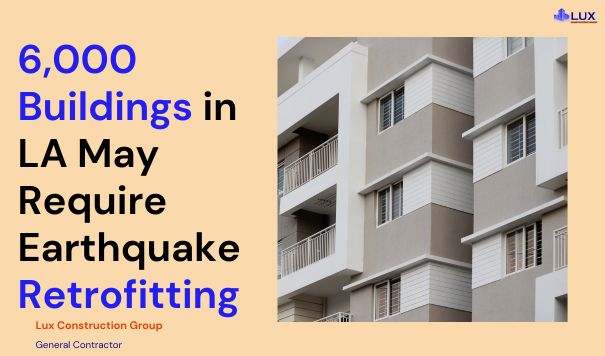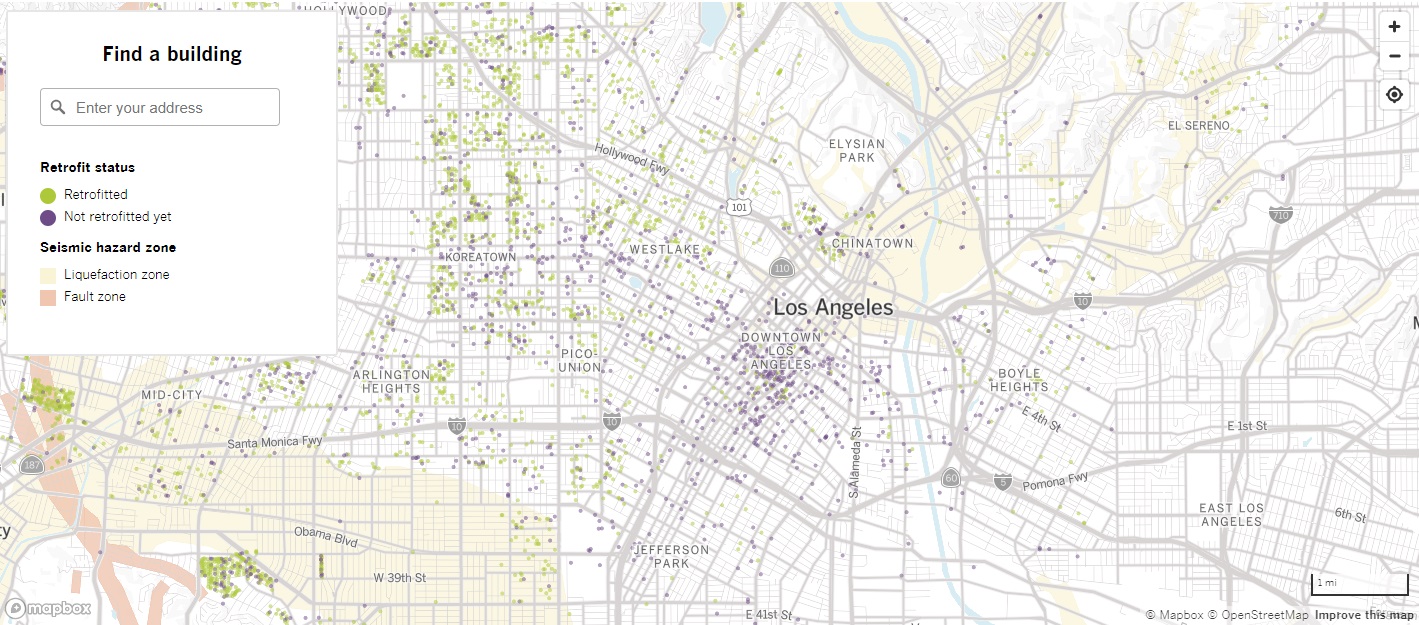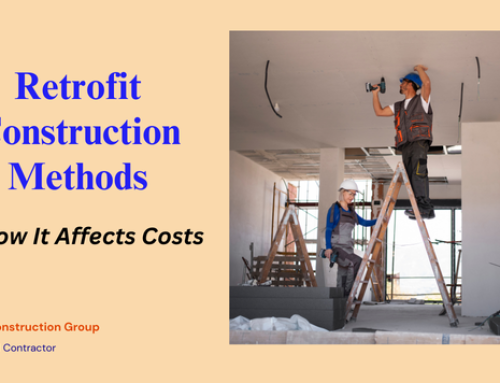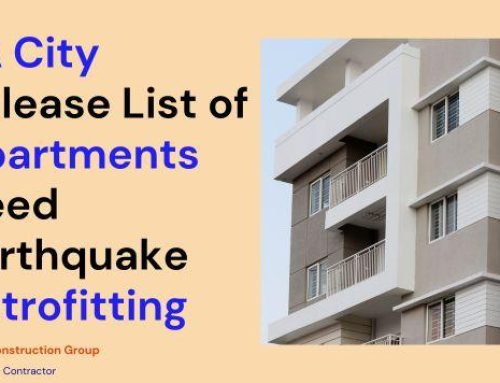If your home or office building was constructed before 1996 in the Los Angeles area, your property may require seismic retrofitting to strengthen its resistance against earthquakes.
Seismic retrofitting reinforces older buildings, making them better able to withstand seismic shaking and less likely to collapse or sustain damage. Depending on the building type, retrofitting fixes can include installing steel frames or beams, constructing new concrete walls, or repairing weak welded joints.
Local governments in Southern California independently determine whether older buildings must undergo retrofitting or demolition. Cities survey buildings to figure out which ones need work. Most cities that recently passed retrofit laws started with “soft-story” buildings first. These are typically low-rise apartment buildings with a weak first floor for parking.
According to records from the Los Angeles Times, about 6,000 buildings in Southern California have been identified as potentially requiring seismic retrofits. Cities that recently passed retrofit ordinances include Los Angeles, Torrance, Pasadena, Santa Monica, Culver City, West Hollywood, and Beverly Hills.
Los Angeles and Santa Monica lead the way in seismic retrofits
Most of the Buildings Awaiting Improvements Are Soft-story Condos and Apartments
So, being a resident or worker in an older structure, monitoring your local jurisdiction’s seismic safety policies is crucial. Proactive retrofitting can safeguard your home, workplace, and the broader community against future earthquake risks.
Contents
- Seismic Retrofit Progress in Los Angeles
- Earthquake Retrofit Map for Los Angeles and Surrounding Areas
- Search the Map
- What the Earthquake Retrofit Map Can Tell
- Limitations of the Earthquake Retrofit Map
- Los Angeles County’s Growing List of Buildings Requiring Earthquake Retrofits
- Upcoming Deadlines for Earthquake Retrofits in Los Angeles
- Wrapping Up!
- FAQs
- What is a seismic retrofit?
- What types of buildings are covered under the ordinances?
- Why isn’t my building on the list, even though my city has an ordinance?
- Why was my building taken off the map?
- Why isn’t my city on the map?
- I’m an owner. What should I do?
- I’m a Renter. What should I do?
- What are liquefaction and fault zones?
Seismic Retrofit Progress in Los Angeles
Before the devastating Northridge earthquake that struck Los Angeles County in January 1994, numerous cities within the county had retrofit laws in the books. However, these laws primarily targeted older brick buildings, leaving many other vulnerable structures unaddressed. In 2013, an investigation by the Los Angeles Times shed light on the risks associated with these unreinforced structures.
Since 2015, at least seven cities across the Los Angeles region have passed ordinances that mandate seismic retrofitting for specific building types prone to earthquake damage. These include soft-story and non-ductile concrete structures.
In Los Angeles, many of the deadlines for retrofitting larger soft-story buildings have already passed. However, some of these deadlines were extended due to the disruptions caused by the COVID-19 pandemic.
Earthquake Retrofit Map for Los Angeles and Surrounding Areas
The Los Angeles Times has compiled a comprehensive map that provides insights into the progress of seismic retrofitting efforts across various cities in the region. This interactive map allows users to search and find details about more than 16,000 buildings for which the Times has obtained data from local authorities.
Search the Map
What the Earthquake Retrofit Map Can Tell
- Building Identification: The map indicates buildings that city officials have identified as potentially requiring seismic retrofitting. This identification process involves visual inspections, on-site assessments, or the use of tools like Google Maps.
- Retrofit Status: For cities like Los Angeles, Pasadena, Santa Monica, and West Hollywood, which have enacted retrofit ordinances, the map displays the current status of retrofitting for individual buildings.
- Fault and Liquefaction Zones: The map highlights buildings located in areas prone to ground rupture or liquefaction during earthquakes, posing additional risks.
Limitations of the Earthquake Retrofit Map
- Safety Assurance: The retrofit status displayed on the map does not guarantee structural safety or confirm potential deficiencies in the event of an earthquake.
- Incomplete Data: The map does not represent a comprehensive overview of all buildings in the region. It excludes structures built after 1996, those located in cities without recent retrofit ordinances for that specific building type, or cases where cities provided incomplete data.
It’s important to note that the building statuses shown on the map are directly sourced from official city records. If any information appears inaccurate or concerning, users are encouraged to reach out to the Los Angeles Times for clarification or assistance.
Los Angeles County’s Growing List of Buildings Requiring Earthquake Retrofits
In L.A., there is no centralized database of earthquake-vulnerable buildings. To create this comprehensive map, reporters from the Los Angeles Times requested public records from each city that has recently adopted seismic retrofit ordinances. While the city of Beverly Hills provided a list of buildings, it did not respond to requests for clarification about the data.
Among the cities in the region, Santa Monica and Los Angeles have made the most significant progress in retrofitting soft-story and non-ductile concrete buildings. Santa Monica has taken the lead, with 57% of its identified buildings having undergone seismic upgrades. In Los Angeles, nearly 75% of qualifying soft-story and 6% of non-ductile concrete buildings have been retrofitted.
For concrete buildings, primarily located in downtown Los Angeles, the retrofit process can be time-consuming, often taking five to six years. However, Craig Chamberlain, president of the Structural Engineers Assn. of Southern California (SEAOC), views the current count of 73 retrofitted concrete structures as a positive sign of progress, with the pace expected to accelerate in the future.
The SEAOC offers a program called Safer Cities, which collaborates with municipalities to assist them in drafting retrofit ordinances and promoting seismic safety awareness. With the organization’s support, the city of Torrance recently passed an ordinance mandating seismic retrofits for soft-story buildings.
Many of the Los Angeles neighborhoods that have completed retrofits are located on the Westside, an area known for its affluence and larger population of white residents. In contrast, major cities in southern Los Angeles County, such as Inglewood and Compton, do not have earthquake-retrofit ordinances in place, leaving residents of color and lower-income communities more vulnerable to seismic risks.
Upcoming Deadlines for Earthquake Retrofits in Los Angeles
Despite construction delays caused by the COVID-19 pandemic, the city of Los Angeles has set an ambitious target: 60% of the remaining soft-story buildings in need of seismic retrofitting must be completed by 2024.
For non-ductile concrete buildings, a different timeline applies. With the exception of a few cases, all such buildings must have initial retrofit construction plans on file by 2028, while the actual retrofit deadline for most is set for 2042.
In the coming years, the number of buildings requiring earthquake retrofits in Los Angeles County is expected to increase further. By the summer of 2024, the county anticipates passing an ordinance targeting high-rise non-ductile concrete buildings in unincorporated areas, where approximately 1 million people reside. This ordinance will include a 10-year deadline for completing the necessary retrofits.
Non-ductile concrete buildings pose the greatest risk to life safety, alongside unretrofitted older brick buildings. Both of these building types are now considered so hazardous that their construction is no longer permitted under current building codes. Soft-story buildings, while generally simpler to retrofit, put lives and the availability of affordable housing at significant risk.
The 1994 Northridge earthquake serves as a stark reminder of the devastating consequences of inadequate seismic reinforcement. The single greatest loss of life occurred due to the collapse of a soft-story apartment building, resulting in 16 fatalities. Approximately 200 soft-story buildings collapsed during that earthquake. Currently, our analysis has identified 4,662 soft-story buildings that may require retrofitting in the Los Angeles area.
Wrapping Up!
For Los Angeles residents and property owners, understanding and adhering to these local retrofit ordinances is crucial for safeguarding lives and property against future seismic events.
Through proactively reinforcing vulnerable structures, communities across Southern California can improve their resilience and preparedness for earthquakes.
FAQs
What is a seismic retrofit?
A seismic retrofit is a process of strengthening existing buildings to make them better able to withstand shaking during an earthquake, reducing the risk of collapse or damage.
What types of buildings are covered under the ordinances?
The retrofit ordinances target several types of vulnerable buildings, including:
- Soft-story buildings: These were built before the 1980s and have upper floors supported by slender columns or poles, such as those holding up carports in apartments. During an earthquake, these weak supports can snap, causing the building to collapse.
- Non-ductile concrete buildings: Built before the 1980s, these lack sufficient steel reinforcement in their concrete frames, which can lead to concrete exploding out of the columns during shaking.
- Steel moment-frame buildings: Those built between the 1970s and 1990s had flaws in their design, welding, and inspection, making them vulnerable.
Some cities have also included unreinforced masonry (brick) buildings, concrete tilt-up buildings (like warehouses), and other types in their retrofit ordinances.
Why isn’t my building on the list, even though my city has an ordinance?
There could be several reasons why a building is not on the list, even if your city has a retrofit ordinance:
- The city hasn’t assessed or identified all the buildings needing retrofits yet.
- The building may have been deemed not to need a retrofit after further evaluation by an engineer.
- The list doesn’t include buildings covered by older ordinances (e.g., Los Angeles’ 1981 law for brick buildings) or buildings owned by the government.
- Single-family homes are generally excluded from these inventories, though some may need retrofitting.
- The ordinance might not cover your specific building type or have exemptions (e.g., condos in West Hollywood).
Why was my building taken off the map?
A building may have been removed from the map if it was demolished or reclassified as a different structure type not subject to the retrofit ordinance.
Why isn’t my city on the map?
The map currently includes only cities in Los Angeles County that have passed recent retrofit ordinances since 2015 (Los Angeles, Torrance, Pasadena, Santa Monica, Culver City, West Hollywood, and Beverly Hills). Most cities in California have not ordered retrofits for vulnerable building types like soft-story apartments, non-ductile concrete, or steel moment-frame buildings.
I’m an owner. What should I do?
If you’re a building owner, you should contact a structural engineer to have your property assessed for potential retrofitting needs. The Structural Engineers Association of Southern California (SEAOSC) has a “find an engineer” feature on its website to help locate qualified professionals.
I’m a Renter. What should I do?
As a renter, you can contact your landlord to inquire about the structural integrity of your building. If your landlord is unresponsive, you can reach out to local government agencies or organizations like Shape Your L.A. to check if a retrofit ordinance or inventory is being considered for your building type.
What are liquefaction and fault zones?
- Liquefaction zone: During an earthquake, shaking can cause loose, water-saturated soil to behave like quicksand, leading to ground failure. These zones are mapped by the California Geological Survey to indicate the potential risk of liquefaction, requiring further investigation on specific parcels.
- Fault zone: When an earthquake ruptures the Earth’s surface, buildings straddling the fault line can be torn apart. The fault zones on the map, identified by the California Geological Survey, indicate areas where further investigation is needed to determine if a specific parcel is directly on a fault line.
Please note that while these zones indicate potential risks, they do not necessarily mean that ground failure or surface rupture will occur on every parcel within the zone during a particular earthquake.
Article Reference LA Times










